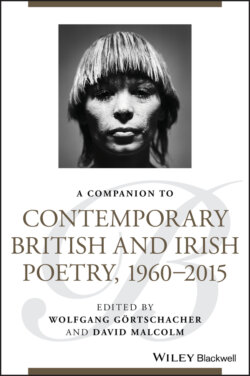Читать книгу A Companion to Contemporary British and Irish Poetry, 1960 - 2015 - Группа авторов - Страница 23
Tony Harrison, “Turns” (1978) (Harrison 1984, 149)
Оглавление“Turns” has 16 lines, but is usually seen as a species of deviant sonnet. It certainly maintains a fundamentally iambic, 10‐syllable line throughout. It also has a variation on the complex rhyme scheme one associates with the sonnet. The paradox in the choice of genre—as in the case of Heaney's “Requiem for the Croppies”—lies in the way in which a traditional and established form is used to attack and subvert traditional and established order.
On the one hand, the text is marked by extreme regularity and in accord with tradition. Iambic feet (including diambs and even a triamb [“in purple Indian ink”]) dominate the poem. Lines are of a consistent 10‐syllable length, although line 2 has 12 syllables (and is an alexandrine), and line 7 has 9 syllables. There is a rhyme scheme, and it is, to a degree, regular. The first four lines run abab; lines 9–12 are effe; and lines 13–16 are ghgh. Deviance occurs to some extent in the second quatrain, which is not, in fact, a quatrain, but two pairs of rhyming lines attached to other sections. Thus, lines 5 and 6 set up a cd pattern that is taken up in lines 7 and 8, but the rhyming lines are separated by a section break, enacting a break between son and father, which is far from absolute.
Despite its closely ordered echoes of the sonnet, the poem is riven by technical tensions (and, thus, enacts its subject matter of generational and social strain). There is very little phonological patterning in the poem (no sonic regularity), except in the conclusive and rhetorically powerful last two lines, with their resounding /b/, /s/, and /k/ sounds. The lines may almost all have 10 syllables, but stress placement is not regular and is often unresolved. For example, line 1 can have five or six main stresses, depending on a choice to accent “more” and “class.” Line 10 must surely have seven main stresses, including the irreducible “H A H” of the father's initials, which must be scanned /// (a molossus). In line 8, there is a tension between a metronomic scansion and one more in accord with natural speech; it could be seen as consisting of a single main stress followed by five iambic feet, or as /x/|x/|x/x|/// (although even other scansions are possible). Line 14 is barely iambic and could be scanned in at least two ways: /x/|x/|x/xx|x/ or ///|x/|//x|//. This irresolution contests orderliness and control. Linguistically, the formal sonnet is permeated by informal lexis: “so folk might think” (line 11), “nowt” (line 13), “trap” (line 14), and “busk” (especially as a transitive verb) (line 15). Finally, too, it must be stressed that this is a 16‐line sonnet, and by definition deviant and contestatory. It enacts a defiance of tradition and established order, while practicing tradition and order, and employing them for its dissenting purposes.
